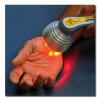CYBERMED LIFE - ORGANIC & NATURAL LIVING
CYBERMED LIFE - ORGANIC & NATURAL LIVING
 Laser Treatment - Low-Level: Low-level laser therapy (LLLT) is a medical treatment that applies low-level (low-power) lasers or light-emitting diodes (LEDs) to the surface or orifices of the body. Whereas "high-power" lasers are used in laser medicine to cut or destroy tissue, low-power lasers are claimed to relieve pain or to stimulate and enhance cell function.
Laser Treatment - Low-Level: Low-level laser therapy (LLLT) is a medical treatment that applies low-level (low-power) lasers or light-emitting diodes (LEDs) to the surface or orifices of the body. Whereas "high-power" lasers are used in laser medicine to cut or destroy tissue, low-power lasers are claimed to relieve pain or to stimulate and enhance cell function.
The effects of LLLT appear to be limited to a specified set of wavelengths of laser, and administering LLLT below the dose range does not appear to be effective.
Despite a lack of consensus over its validity, some studies suggest that LLLT may be modestly effective, but in most cases no better than placebo, in relieving short-term pain for rheumatoid arthritis, osteoarthritis, acute and chronic neck pain, tendinopathy, and possibly chronic joint disorders. The evidence for LLLT being useful in the treatment of low back pain, dentistry and wound healing is unclear.